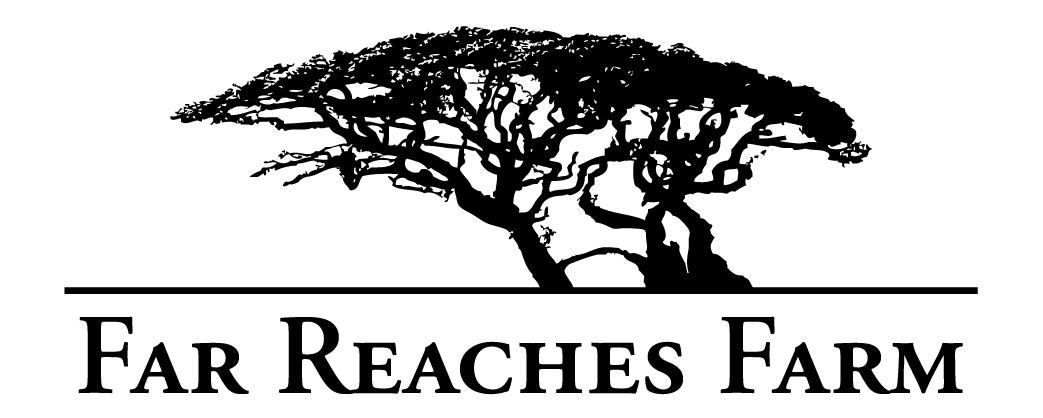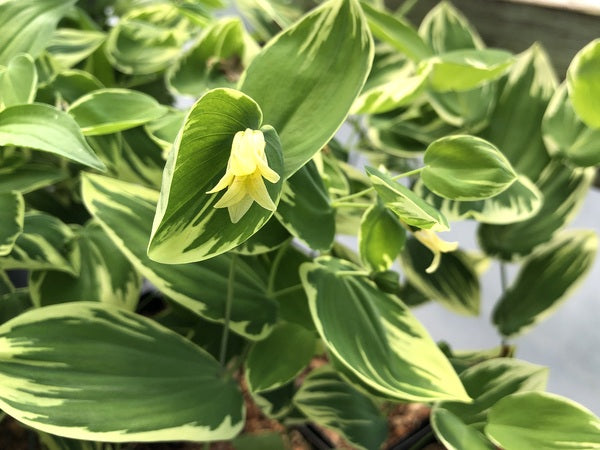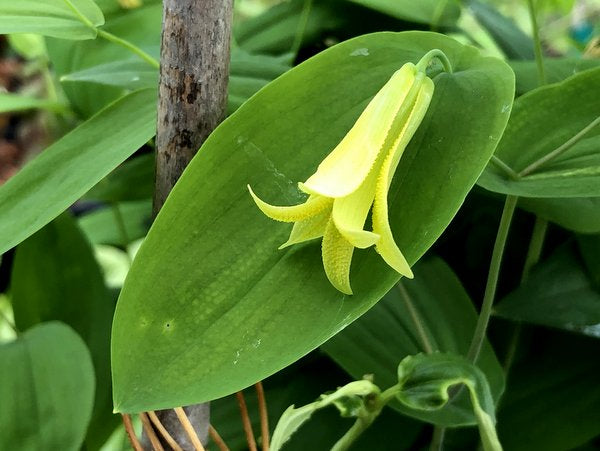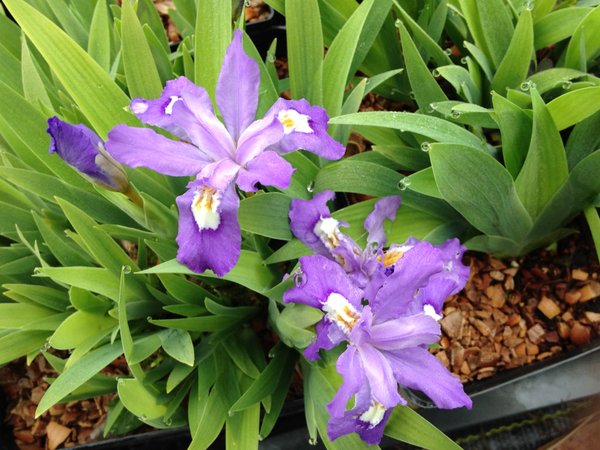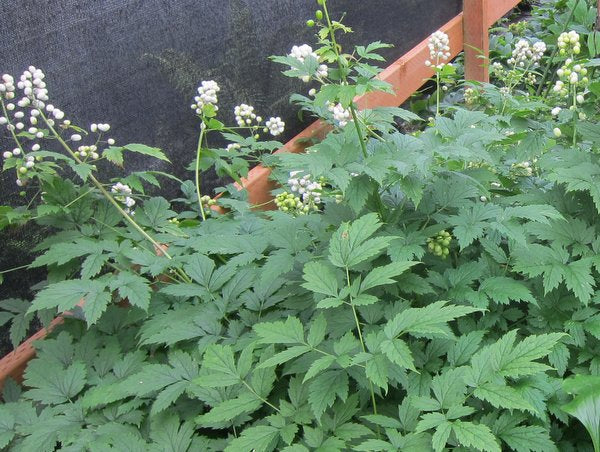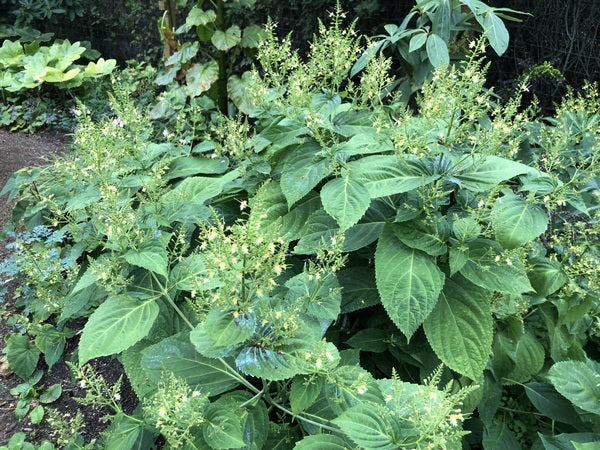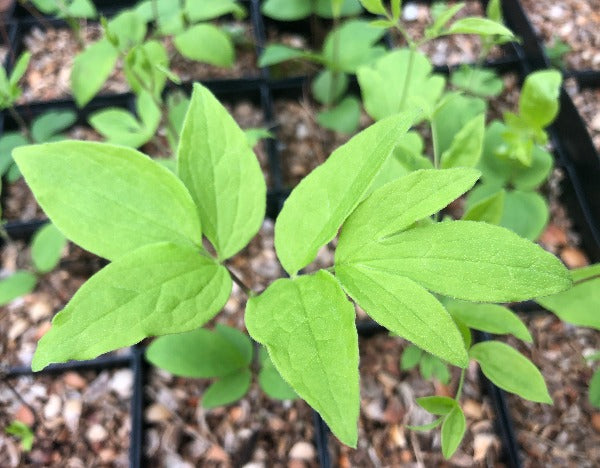Sort by:
53 products
53 products
A nice find in the woods of North Carolina, this variegated Perfoliate Bellwort is a choice addition to the shade garden. Creamy, feathered markings adorn the margins of the perfoliate leaves which pair nicely with the creamy white flowers. Perfoliate means the leaf surrounds the stem so it looks like the stem runs through the leaf. Slow to increase, we don't have many.
Perfoliate Bellwort. So named for the perfoliate leaves in which the stem seems to pierce the leaf and bellwort for the pendant pale yellow (in this form) to greenish flowers. This is a collection from Hamblen County Tennessee shared with us by botanist Aaron Floden. A delight in the shade garden contrasting well with dark Podophyllums and ferns.
One of the darkest of the cristata selections, the violet-blue petals are made to appear even darker by the little thumbprint of yellow and white at their bases. A small but mighty little woodland creeper which would revel in bright shade or morning sun. The thin rhizomes trundle along on the surface and are plenty hardy so don't bury them in mulch!
Midwestern native Hepatica whose name has been changed to Anemone acutiloba or some prefer Anemone nobilis var. acuta. We cling to Hepatica, kicking and screaming. These are from seed from the unparalleled collection at Ashwood Nurseries and are not wild collected plants. This has leaves with sharply pointed lobes and usually white but sometimes pinkish flowers sometimes well-displayed on erect stems above the leaves. Good plant for the woodland garden where it plays well with the early Trilliums, Cardamines and various early spring ephemera.
Doll's Eyes Baneberry. Striking woodland plant in fruit - the white puffs of flowers in late spring are ok but the fruit is serious business. An elongated fruiting spike holds with red stems, round white berries each with a small black pupil. The common name is immediately obvious and is either clever or creepy depending on how many "Chucky" movies you have watched. We think it is clever. All parts poisonous which means deer proof.
This is the rarest US Magnolia species occurring in just 6 counties in the Florida panhandle. Fantastic species with huge leaves up to 2' or more long and nearly a foot across. On plants young as 3-4 years old, white scented flowers to 10" wide appear in May avoiding frost damage . Dramatic large shrub to small tree. Best protected from too much wind and protected in zone 6 winters until well established. Ours are seed-grown from private property in Walton County.
Heal-All, Stone Root. Tuberous form of this widespread East Coast species which we received from Aaron Floden. Widely used in ethnobotany and homeopathy, this is an interesting shade ornamental in its own right. Broad soft leaves and curious late-season, creamy yellow flowers whose strong Lemon Pledge scent will put a shine on your garden.
This Southeastern native is a very exotic looking Carex - so much so that it was placed in a separate genus Cymophyllus but recent DNA work confirms it is a Carex. The wide green semi-horizontal leaves look far more exotic than a grass and the truly unusual white flowers just adds confirmation. Shade and moist, these are divisions from our plant of many years which is important as this is threatened in the wild by habitat loss and grazing.
Oyster Leaf. The leaves are edible and taste - and feel - exactly like raw oysters. If raw oysters are your thing, this is an OMG veg alternative. The now closed El Bulli in Catalonia, regarded as one of the greatest restaurants ever, ran with Oyster Leaf innovative ways. Loved to have tried the leaves striped in golden caviar and splashed with Grey Goose. Beautiful glaucous blue-green leaves on sprawling stems tipped in small sky blue flowers. This likes ample nutrition. Perennial and dormant in winter. This is a plant of just above high tide line on cold northern hemisphere beaches from Maine to Greenland and Japan to Alaska so if you have a cool to cold garden, here you go.
Rare and elusive in commerce, this is a denizen of the New Jersey Pine Barrens and moist areas along the Eastern Seaboard. When in flower, it always strikes us as looking more extra-terrestrial than a product of our own earthly evolution. Bizarre pink cones of small packed flowers studded with blue anthers are just a giggle. Rich moist soil in some shade. This is Federally listed as endangered and threatened. Our plant was received many years ago from the Rhododendron Species Botanic Garden who grew it from seed and we have propagated it like mad here at the nursery so our conscience is clear.
Maidenhair Spleenwort. We love common names. We must dig out our 15th century Herbal and read up on how to properly decoct this sweet little fern for afflicting humors of the spleen. Or we can just grow it in a gritty well-drained shaded rock garden and enjoy its evergreen delicate appearance which belies its rugged constitution. This little fern grows throughout the northern part of the northern hemisphere and just has a small foothold in our North Cascades. One of our favorite sights of this fern was when we did the Coast to Coast walk in northern England in the epic rainy summer of 2012 and we walked close to 200 miles through the Lakes District and Yorkshire Dales and Moors. We saw this growing everywhere naturalized on old stone walls, stone bridges and stone buildings. Very attractive and a clue to its drainage preferences.
A very fine Trillium from west of the Appalachian Mts, this has pedicellate (on a stem) red flowers. This is an easy one and will increase by both offsets and by seeding. It is a good one to grow with other species like erectum as it enjoys casual sex, producing interesting colors in seedlings years hence.
A graceful Trillium native from Minnesota to Alabama and which has been a very good plant in our garden. White flowers in April above three broad green leaves and can be quite robust getting up to 2 feet tall and making multiple stems per bulb. And the darned thing is seeding itself around in the garden - lucky us! Our own slow propagations - not wild collected.
Merry Bells. One of our favorite of the Midwest and Eastern woodland wildflowers. Rich gold pendant flowers dangling like earrings on a woman of some serious substance. Combines beautifully with upper crust plants such as Cardiocrinums and Arisaemas yet hangs comfortably with box store Hostas. These are divisions from our stock plants.
An Aaron Floden collection of this Eastern US native clematis with vibrant hot-pink to purple bell-shaped flowers with a cream-colored interior conjuring up cheerful memories of berries and cream on a hot summer's day. Herbaceous and needs a good whack each year but will reward you with annually increasing robustness for your efforts.
Eastern species with nodding flowers of pure deep red. These are nice, blooming seedlings from plants Sue brought from her old nursery in Vermont. Parted with reluctantly and Sue reserves the right to take them back if she deems it appropriate for the welfare of the Trillium. Personally we like Trilliums that clump up sufficiently to divide and this is one of those species.
Hamilton Dwarf Cranberry. This is one of our desert island dwarf shrublets. Granted, we would be bundled up on the beach as this would be a cool northern island for this to be happy but that is a small concession for 12 months of beauty. Perfection in a small package with very slow growth, evergreen leaves turning burgundy in winter, tiny pink flowers and red fruit - yea, verily!
A selection by a wildflower nursery in Virginia of this valued Eastern woodlander. Not the aggressive species found in commercial landscapes but one much more choice and selected forms are desirous. Some silvering to the leaves on this form - admittedly the variations can be subtle but more pronounced after a visit to the pot dispensary.
